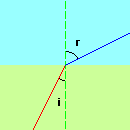 Waves travel at different speed through different mediums, hence if a wave passes from one material into another at any angle other than
perpendicular to the interface, it will change direction. This effect is known as refraction.
Waves travel at different speed through different mediums, hence if a wave passes from one material into another at any angle other than
perpendicular to the interface, it will change direction. This effect is known as refraction.
 LIGHT WAVES Refraction.
LIGHT WAVES Refraction.
Refraction
 Waves travel at different speed through different mediums, hence if a wave passes from one material into another at any angle other than
perpendicular to the interface, it will change direction. This effect is known as refraction.
Waves travel at different speed through different mediums, hence if a wave passes from one material into another at any angle other than
perpendicular to the interface, it will change direction. This effect is known as refraction.
The amount of refraction depends on the relative speeds of the wave in the different material, for instance in the diagram oppposite
Notes:

